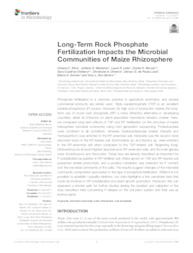Long-term rock phosphate fertilization impacts the microbial communities of maize rhizosphere.
Long-term rock phosphate fertilization impacts the microbial communities of maize rhizosphere.
Author(s): SILVA, U. C.; MEDEIROS, J. D.; LEITE, L. R.; MORAIS, D. K.; CUADROS-ORELLANA, S.; OLIVEIRA-PAIVA, C. A.; LANA, U. G. de P.; GOMES, E. A.; SANTOS, V. L. dos
Summary: Phosphate fertilization is a common practice in agriculture worldwide, and several commercial products are widely used. Triple superphosphate (TSP) is an excellent soluble phosphorus (P) source. However, its high cost of production makes the longterm use of crude rock phosphate (RP) a more attractive alternative in developing countries, albeit its influence on plant-associated microbiota remains unclear. Here, we compared long-term effects of TSP and RP fertilization on the structure of maize rhizosphere microbial community using next generation sequencing. Proteobacteria were dominant in all conditions, whereas Oxalobacteraceae (mainly Massilia and Herbaspirillum) was enriched in the RP-amended soil. Klebsiella was the second most abundant taxon in the RP-treated soil. Burkholderia sp. and Bacillus sp. were enriched in the RP-amended soil when compared to the TSP-treated soil. Regarding fungi, Glomeromycota showed highest abundance in RP-amended soils, and the main genera were Scutellospora and Racocetra. These taxa are already described as important for P solubilization/acquisition in RP-fertilized soil. Maize grown on TSP and RP-treated soil presented similar productivity, and a positive correlation was detected for P content and the microbial community of the soils. The results suggest changes of the microbial community composition associated to the type of phosphate fertilization. Whilst it is not possible to establish causality relations, our data highlights a few candidate taxa that could be involved in RP solubilization and plant growth promotion. Moreover, this can represent a shorter path for further studies aiming the isolation and validation of the taxa described here concerning P release on the soil plant system and their use as bioinoculants.
Publication year: 2017
Types of publication: Journal article
Unit: Embrapa Maize & Sorghum
Keywords: Comunidade microbiana, Fosfato de rocha, Rizosfera
Observation
Some of Embrapa's publications are published as ePub files. To read them, use or download one of the following free software options to your computer or mobile device. Android: Google Play Books; IOS: iBooks; Windows and Linux: Calibre.
Access other publications
Access the Agricultural Research Database (BDPA) to consult Embrapa's full library collection and records.
Visit Embrapa Bookstore to purchase books and other publications sold by Embrapa.

